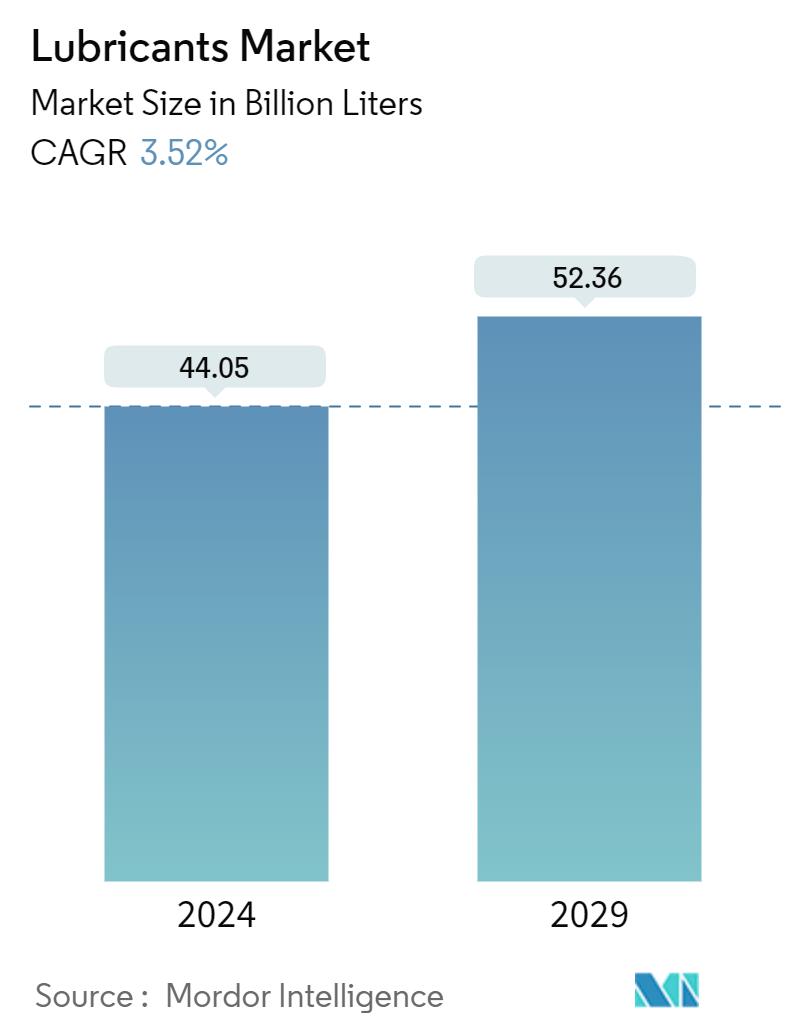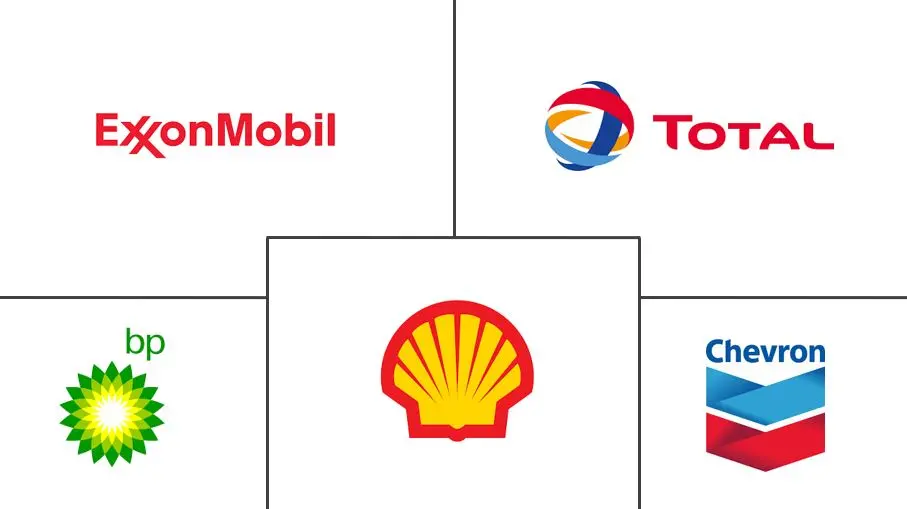Market Size of Lubricants Industry

| Study Period | 2019 - 2029 |
| Base Year For Estimation | 2023 |
| CAGR (2024 - 2029) | 3.52 % |
| Fastest Growing Market | Asia Pacific |
| Largest Market | Asia Pacific |
| Market Concentration | High |
Major Players
*Disclaimer: Major Players sorted in no particular order |
Lubricants Market Analysis
The Lubricants Market size is estimated at 44.05 Billion liters in 2024, and is expected to reach 52.36 Billion liters by 2029, at a CAGR of 3.52% during the forecast period (2024-2029).
The outbreak of the COVID-19 virus caused several challenges for the global automotive industry, as vehicle production and sales suddenly stopped in many countries. These work stoppages led to a loss in the production of millions of vehicles worldwide. In the automobile industry, lubricants are used to reduce friction and wear in the engine, prevent rusting, and cool the pistons, among other functions.
- In the short term, a major factor driving the market studied is the increasing demand for high-performance lubricants (owing to their better and improved properties, such as reduced flammability, reduced gear wear, and increased service life).
- On the flip side, increasing drain intervals in the automotive and industrial sectors and the modest impact of EVs are expected to hinder the growth of the market studied in the forecast period shortly.
- Engine oil dominated the market and is expected to grow during the forecast period, as it is widely used to lubricate internal combustion engines.
- Growing prominence for bio-lubricants is likely to act as an opportunity in the future.
- The global market for lubricnats is dominated by the Asia-Pacific region.
Lubricants Industry Segmentation
A combination of base oils and additives produces lubricant products. The composition of base oil in the formulation of lubricants is primarily between 75-90%. Base oils possess lubricating properties and make up to 90% of the final lubricant product.
The lubricants market is segmented by group, base stock, product type, end-user industry, and geography. By group, the market is segmented into Group I, Group II, Group III, Group IV, and Group V. By base stock. The market is segmented into mineral oil lubricants, semi-synthetic lubricants, synthetic lubricants, and bio-based lubric ants. The market is segmented by product type into engine oil, transmission and hydraulic fluid, metalworking fluid, general industrial oil, gear oil, grease, process oil, and other product types. The end-user industry segments the market into power generation, automotive and other transportation, heavy equipment, food and beverage, metallurgy and metalworking, chemical manufacturing, and other end-user industries, including packaging, oil, gas, etc. The report also covers the market size and forecasts for the lubricants market in 33 countries across major regions. The market sizing and forecasts for each segment are based on volume (liters).
| Group | |
| Group I | |
| Group II | |
| Group III | |
| Group IV | |
| Group V |
| Base Stock | |
| Mineral Oil Lubricant | |
| Synthetic Lubricant | |
| Semi-synthetic Lubricant | |
| Bio-based Lubricant |
| Product Type | |
| Engine Oil | |
| Transmission and Hydraulic Fluid | |
| Metalworking Fluid | |
| General Industrial Oil | |
| Gear Oil | |
| Grease | |
| Process Oil | |
| Other Product Types |
| End-user Industry | |
| Power Generation | |
| Automotive and Other Transportation | |
| Heavy Equipment | |
| Food and Beverage | |
| Metallurgy and Metalworking | |
| Chemical Manufacturing | |
| Other End-user Industries (Packaging, Oil, and Gas) |
| Geography | ||||||||||||
| ||||||||||||
| ||||||||||||
| ||||||||||||
| ||||||||||||
| ||||||||||||
|
Lubricants Market Size Summary
The lubricants market is poised for steady growth over the forecast period, driven by the increasing demand for high-performance lubricants with enhanced properties such as reduced flammability and extended service life. The automotive sector, particularly the internal combustion engine segment, remains a significant consumer of lubricants, with engine oils leading the market. However, the market faces challenges from longer drain intervals in the automotive and industrial sectors and the modest impact of electric vehicles. Despite these challenges, the growing interest in bio-lubricants presents new opportunities for market expansion. The Asia-Pacific region dominates the global lubricants market, supported by a robust automotive production base and increasing demand in wind power and chemical manufacturing industries.
The Asia-Pacific region, led by China, is the largest consumer of lubricants, with significant contributions from the automotive and wind power sectors. The region's dominance is further bolstered by the rapid growth of the electric vehicle industry in South Korea and initiatives in India to boost EV adoption. The market is consolidated among major players like Exxon Mobil, Chevron, BP, Shell, and TotalEnergies, who are actively engaging in strategic partnerships and acquisitions to expand their market presence. Recent developments include Shell's acquisition of MIDEL and MIVOLT product lines and HPCL's long-term agreement with Chevron Brands International for the distribution of Caltex-branded lubricants in India. These strategic moves are expected to enhance the competitive landscape and drive market growth during the forecast period.
Lubricants Market Size - Table of Contents
-
1. MARKET DYNAMICS
-
1.1 Drivers
-
1.1.1 Increasing Usage of High-performance Lubricants
-
1.1.2 Demand from the Growing Wind Energy Sector
-
1.1.3 Expansion of the Global Cold Chain Market
-
-
1.2 Restraints
-
1.2.1 Increasing Drain Intervals in the Automotive and Industrial Sectors
-
1.2.2 Modest Impact of Electric Vehicles (EVs) in the Future
-
-
1.3 Industry Value Chain Analysis
-
1.4 Porter's Five Forces Analysis
-
1.4.1 Bargaining Power of Suppliers
-
1.4.2 Bargaining Power of Buyers
-
1.4.3 Threat of New Entrants
-
1.4.4 Threat of Substitute Products and Services
-
1.4.5 Degree of Competition
-
-
1.5 Regulatory Policy Analysis
-
-
2. MARKET SEGMENTATION (Market Size in Volume)
-
2.1 Group
-
2.1.1 Group I
-
2.1.2 Group II
-
2.1.3 Group III
-
2.1.4 Group IV
-
2.1.5 Group V
-
-
2.2 Base Stock
-
2.2.1 Mineral Oil Lubricant
-
2.2.2 Synthetic Lubricant
-
2.2.3 Semi-synthetic Lubricant
-
2.2.4 Bio-based Lubricant
-
-
2.3 Product Type
-
2.3.1 Engine Oil
-
2.3.2 Transmission and Hydraulic Fluid
-
2.3.3 Metalworking Fluid
-
2.3.4 General Industrial Oil
-
2.3.5 Gear Oil
-
2.3.6 Grease
-
2.3.7 Process Oil
-
2.3.8 Other Product Types
-
-
2.4 End-user Industry
-
2.4.1 Power Generation
-
2.4.2 Automotive and Other Transportation
-
2.4.3 Heavy Equipment
-
2.4.4 Food and Beverage
-
2.4.5 Metallurgy and Metalworking
-
2.4.6 Chemical Manufacturing
-
2.4.7 Other End-user Industries (Packaging, Oil, and Gas)
-
-
2.5 Geography
-
2.5.1 Asia-Pacific
-
2.5.1.1 China
-
2.5.1.2 India
-
2.5.1.3 Japan
-
2.5.1.4 South Korea
-
2.5.1.5 Philippines
-
2.5.1.6 Indonesia
-
2.5.1.7 Malaysia
-
2.5.1.8 Thailand
-
2.5.1.9 Vietnam
-
2.5.1.10 Rest of Asia-Pacific
-
-
2.5.2 North America
-
2.5.2.1 United States
-
2.5.2.2 Canada
-
2.5.2.3 Mexico
-
-
2.5.3 Europe
-
2.5.3.1 Germany
-
2.5.3.2 United Kingdom
-
2.5.3.3 Italy
-
2.5.3.4 France
-
2.5.3.5 Russia
-
2.5.3.6 Turkey
-
2.5.3.7 Spain
-
2.5.3.8 Rest of Europe
-
-
2.5.4 South America
-
2.5.4.1 Brazil
-
2.5.4.2 Argentina
-
2.5.4.3 Chile
-
2.5.4.4 Colombia
-
2.5.4.5 Rest of South America
-
-
2.5.5 Middle-East
-
2.5.5.1 Saudi Arabia
-
2.5.5.2 Iran
-
2.5.5.3 Iraq
-
2.5.5.4 United Arab Emirates
-
2.5.5.5 Kuwait
-
2.5.5.6 Rest of the Middle-East
-
-
2.5.6 Africa
-
2.5.6.1 Egypt
-
2.5.6.2 South Africa
-
2.5.6.3 Nigeria
-
2.5.6.4 Algeria
-
2.5.6.5 Morocco
-
2.5.6.6 Rest of Africa
-
-
-
Lubricants Market Size FAQs
How big is the Lubricants Market?
The Lubricants Market size is expected to reach 44.05 billion liters in 2024 and grow at a CAGR of 3.52% to reach 52.36 billion liters by 2029.
What is the current Lubricants Market size?
In 2024, the Lubricants Market size is expected to reach 44.05 billion liters.

